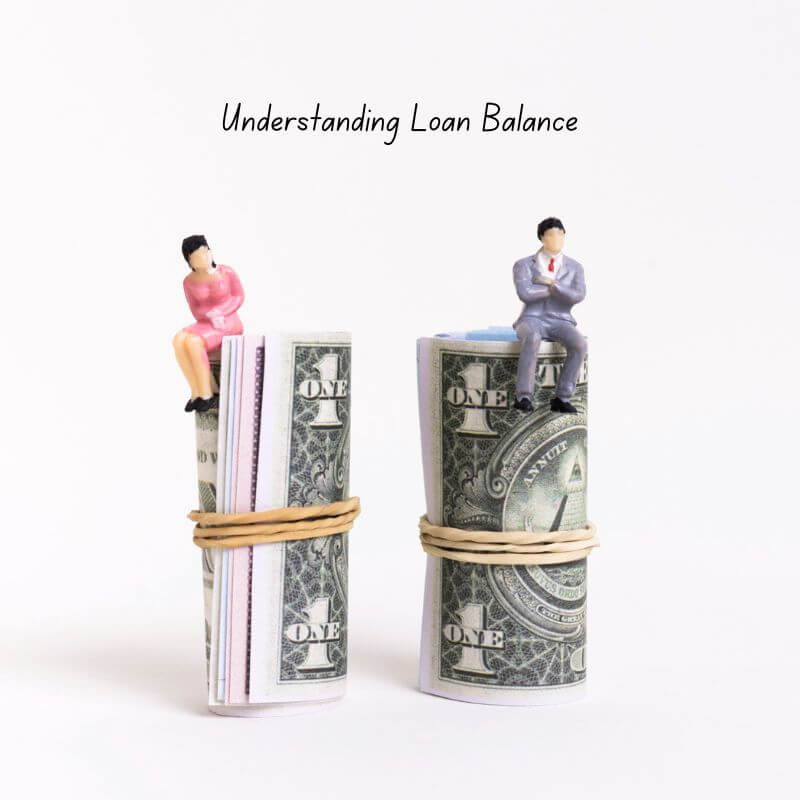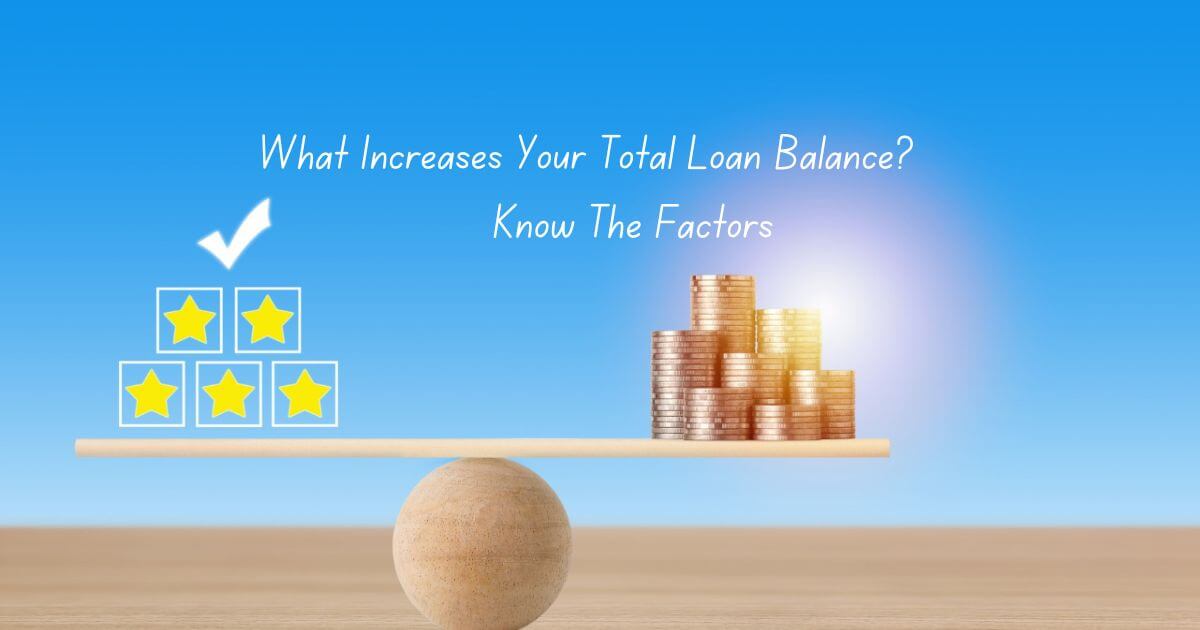Last Updated on May 30, 2024 by Amrita
Taking out a loan can be a helpful tool in achieving your financial goals, whether it’s for education, buying a home, or starting a business. However, the total balance of your loans can often be much higher than the original amount borrowed due to various factors. In this article, I will discuss with you what increases your total loan balance and what you can do to manage it effectively.
Read More: What Is A Navy Federal Pledge Loan? Learn Everything

Key Takeaways:
- The total balance of a loan can be significantly higher than the original amount borrowed due to factors such as interest, fees, and penalties.
- Managing your loans effectively is important in order to avoid increasing your total loan balance and to pay off your debt efficiently.
Understanding Loan Balance
When it comes to understanding your loan balance, there are a few key concepts you should keep in mind. These include the principal amount, interest rate, APR, fees, and loan balance. Knowing what each of these terms means can help you better understand the total cost of borrowing and evaluate any factors that could increase your loan balance.
- Principal amount: This is the initial amount of money that you borrowed from the lender.
- Interest rate: This is the percentage of the principal amount that the lender charges as compensation for lending you money.
- Annual Percentage Rate (APR): APR includes not only the interest charged by the lender but also any fees and other charges associated with the loan. APR gives an accurate representation of the total cost of a loan.
- Fees: These are additional charges that may be associated with taking out a loan, such as origination fees or payment processing fees.
- Loan balance: This is the amount of money that you still owe to the lender. As you make payments on your loan, this balance will decrease over time.
What Increases Your Total Loan Balance? Understanding The Factors
When taking out a loan, it’s important to understand all the factors that can contribute to your total balance increasing over time. This not only helps you stay on top of your payments and avoid any surprises but also allows you to make informed financial decisions.
Fees And Penalties: The Culprits Behind Rising Loan Balances
One of the major factors that can cause an increase in your loan balance are fees and penalties associated with late or missed payments. These fees can range from payment processing charges to account maintenance fees, but the most expensive ones are often late fees.
If you miss a payment deadline, creditors will typically charge a late fee and add it to your next month’s statement. This not only adds to your total balance but also increases the interest you owe, making it more difficult to pay off your loan.
Variable Interest Rates: A Cause Of Fluctuating Loan Balances
Variable interest rates, also known as adjustable rates, can be a major factor in your total loan balance increasing. This is especially true for adjustable loans such as an adjustable-rate mortgage (ARM). With an ARM, the interest rate can rise or fall based on market changes.
If you’re making minimum payments or have a payment cap on your loan, any increase in interest rates can result in the unpaid interest being added to your principal balance. For example, if you have a payment cap of $100 per month and the interest rate increases by $50, the remaining $50 will be added to your total balance.
The Impact Of Capitalized Interest On Your Loan Balance
Another factor that can contribute to your total loan balance increasing is capitalized interest. This occurs when unpaid interest is added to the principal balance of a loan.
It’s important to note that this can happen in various scenarios, such as during deferment or forbearance periods for student loans, or when taking advantage of relief measures offered by lenders during times of financial hardship.
When interest is added to the principal balance, it can cause your total loan balance and monthly payment to increase, resulting in you paying more in interest over time.
The Consequences Of Less-Than-Minimum Payments On Your Loan Balance
Finally, making less-than-minimum payments can also contribute to your loan balance increasing. Lenders typically view any payment that is below the minimum amount owed as a missed payment, which can negatively impact your credit history and lower your credit score.
Additionally, any unpaid principal, penalties or interest charges may be added to your outstanding balance, resulting in an increase in the total amount owed. It’s important to always make at least the minimum payment on your loans to avoid these consequences.
Being aware of these factors and their potential impact on your loan balance is crucial for managing your finances effectively. Always make sure to read the terms and conditions of your loans carefully, stay on top of payments.
SummaryIn summary, there are several factors that can contribute to an increase in your total loan balance. These include fees and penalties associated with late or missed payments, variable interest rates, capitalized interest, and making less-than-minimum payments. It’s important to be aware of these factors and actively manage them by staying on top of payments and communicating with your lender if needed. By doing so, you can avoid any surprises and maintain a healthy financial standing. |
Read More: What Is A Cup Loan Program? | Learn All You Need To Know
How Can You Reduce Your Total Loan Balance? Strategies To Apply

Paying off loans can be a daunting task, but it is necessary to stay on top of your financial health. The good news is that there are several ways to lower your loan balance and make the repayment process more manageable. Here, I will share some strategies you can use to reduce your outstanding loan cost.
##Make Extra Repayments
One of the most effective ways to lower your loan balance is by making extra repayments. This means paying more than the minimum monthly repayment required by your lender. By doing so, you can decrease the principal amount and save thousands of dollars in interest payments over time.
When making additional repayments, it is essential to inform your lender that you want the extra money to go towards paying off the principal amount. This way, you can ensure that your payments are being used to reduce your loan balance rather than covering any fees or interest.
##Find A Lower Interest Rate
Another strategy for lowering your loan balance is by finding a lower interest rate. High-interest rates can significantly increase the cost of borrowing and make it challenging to pay off your loans. By shopping around and comparing rates from different lenders, you may be able to find a better deal that can save you thousands of dollars in the long run.
When considering interest rates, it is essential to understand the difference between fixed and variable rates. Fixed interest rates remain the same throughout the loan term, while variable rates can fluctuate according to market conditions. It is crucial to consider your financial situation and risk tolerance before choosing the type of interest rate for your loans.
##Take Advantage Of Repayment Plans
If you have federal student loans, you may be eligible for income-driven repayment plans such as REPAYE (Revised Pay As You Earn). These plans can help lower your loan balance by forgiving a portion of unpaid interest each month. Participating in these plans can make your loan more manageable and reduce the burden of high-interest rates.
It is essential to note that income-driven repayment plans may extend the loan term, resulting in higher overall interest payments over time. Therefore, it is crucial to carefully consider your options and choose a plan that aligns with your financial goals.
##Negotiate With Your Lender
In some cases, it may be possible to negotiate with your lender for a temporary interest rate reduction. This can provide short-term relief and allow you to pay off more of the principal amount. It is worth exploring this option if you are struggling to keep up with your loan payments.
Also, consider reaching out to your lender if you are facing financial hardship or have experienced a significant life event, such as job loss or illness. They may be able to offer you alternative repayment options that can help reduce your loan balance and make the payments more affordable for you.
##Prioritize Your Most Expensive Loans
When it comes to paying off multiple loans, always prioritize your most expensive loan first. This is usually your student loan, as it tends to have a higher interest rate compared to other types of debt. By focusing on this loan, you can lower its balance quickly and save money in the long run.
In some cases, it may be worth prioritizing your student loans over other debts, such as credit card or personal loan debt. This is because student loans cannot be discharged in bankruptcy, making them a higher financial priority for your long-term stability.
##Auto-Pay For Your Loans
Setting up automatic payments can also help lower your loan balance. Many lenders offer a discount on interest rates when borrowers sign up for auto-pay, which can save you money over time. Additionally, making on-time payments through auto-pay can improve your credit score and make it easier to access credit in the future.
##On Time Payments
Lastly, one of the most crucial strategies for reducing your loan balance is by making on-time payments. Late or missed payments not only result in additional fees and charges, but they can also damage your credit score. By consistently making payments on time, you can demonstrate financial responsibility and improve your overall financial health.
Read More: Is the Cup Loan Program Real Or Fake? Learn The Truth
What Is interest capitalization On A student Loan?
Interest capitalization on a student loan is when any unpaid interest is added to the principal amount of your loan. This means that the total balance of your loan increases, and you will be charged interest on this new, larger balance. As a result, your monthly payments may also increase in order to cover the higher overall amount owed.
However, it’s worth noting that not all unpaid interest will capitalize on your loan. Only under certain conditions, such as when you enter the repayment period after graduation or if you take a break from making payments, will interest capitalize.
Factors That Contribute To Interest Accrual
Interest accrual is a common occurrence when it comes to student loans. It happens when the interest on your loan begins to accumulate and add up over time. However, this is not the only factor that can contribute to an increase in your total loan balance.
Another key contributor is interest capitalization, which occurs when any accrued interest is added to the principal amount of your loan. This means that the amount you owe on your loan can quickly increase, as any unpaid interest is added to the principal balance and becomes subject to future interest charges.
It’s important to keep track of both interest accrual and capitalization, as they can significantly impact the overall cost of your student loans in the long run.
What Is The Student Loan Balance?
Your student loan balance is the total amount of money that you owe for your student loans. This includes both the initial amount borrowed, also known as the principal loan amount and any accrued interest that has not yet been paid off.
As you make payments towards your student loans, your balance will decrease and more of your payment will go towards paying off the principal loan amount. However, if you have unpaid interest, it will continue to accrue and increase your overall balance.
What Is Student Loan Forgiveness?
Student loan forgiveness is a government program that allows individuals who work full-time for a nonprofit or government organization to have the remaining balance of their Direct Loans forgiven after making 120 qualifying payments.
This means that after 10 years of consistent payments, the individual’s federal student loans will be completely forgiven. However, in order to qualify for this program, the individual must also be under an IDR (Income-Driven Repayment) plan, which adjusts the loan payments based on their income.
This program, known as Public Service Loan Forgiveness (PSLF), is a valuable opportunity for those working in public service fields to have their student debt lifted after a decade of dedicated service. So, it can serve as a financial relief for individuals who have chosen to pursue careers in public service, but are burdened by student loan debt.
How Do I Check My Loan Status?
To check the status of your loan, you can visit the nearest branch of your lender and speak with a representative. They will require some information such as your account details to verify your identity.
Once verified, they will be able to provide you with an update on the current status of your loan or even give you a statement of your outstanding balance. This is often the easiest and most reliable way to get the information you need about your loan. However, if visiting a branch is not convenient for you, there are other options available as well.
Additional Reading: Is Coffee Break Loans Legit? | Everything You Need To Know
Loan Balance Vs Account Balance
Loan balance and account balance are two terms that are often used in the financial world but they have different meanings that are important to understand. The loan balance is the amount of money that a borrower owes to another party, such as a bank or a lender.
This could be from a student loan, mortgage, or any other type of loan. It is important to keep track of your loan balance and make timely payments in order to avoid it from increasing over time.
On the other hand, an account balance refers to the amount of money currently in your possession. This could be the balance in your checking or savings account, which can fluctuate depending on your income, expenses, and transactions.
Understanding The Payoff Amount And Loan Balance Difference
When it comes to paying off your loan, understanding the difference between the payoff amount and loan balance is crucial. The payoff amount is the total sum of money that you owe to your lender if you were to pay off your loan in full on a specific day.
It includes not only the outstanding balance of your loan but also any additional fees such as prepayment penalties, unpaid charges, and residual interest. In contrast, the loan balance is the amount that you still have to pay back on your loan without any extra fees or interest included.
This means that even if you check your account and see a certain balance, it may not accurately reflect the actual payoff amount of your loan. Therefore, it is important to contact your lender to get an accurate figure before making any early payments.
Recommended Article: What Increases Your Total Loan Balance?
- True American Loan | Everything You Need To Know
- What Is An ESOP Loan? | Learn What You Need To Know
- Conventional Rehab Loan | Everything You Need To Know
- Forgivable Equity Builder Loan: Who Can Benefit From It?
Final Thought | What Increases Your Total Loan Balance?
Therefore, understanding the factors that can contribute to an increase in your total loan balance is crucial in managing your debt and staying financially stable in the long run.
By being informed and proactive, you can make sound decisions about repayment strategies and avoid falling into debt traps that may hinder your financial success. Remember to prioritize paying off interest and staying current on payments to prevent unexpected growth in your total loan balance over time.
